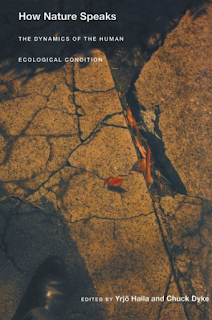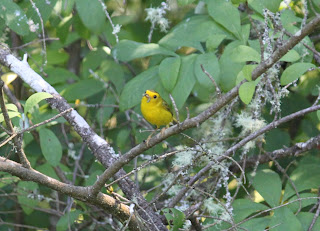 |
| Emily Brontë |
In
How Nature Speaks: The Dynamics of the Human Ecological Condition, Yrjö Haila and Chuck Dyke argue that Romanticism never achieved the transformative understanding of the environment it sought. I contend that Emily Brontë, borrowing from but augmenting Romantic concepts, did generate such an understanding, establishing ideas that can help us today.
Haila and Dyke say that Romanticism “viewed nature as a benign whole offering inspiration and advice to those humans who are open-minded enough to listen.” They go on to explain that the Romantic approach was intended as a counter to the growing emphasis placed on the supremacy of science and rationalism at the time. In their view, the problem for Romanticism originated in its failure “to get liberated from” a basic belief in the “laws of nature,” which were scientific constructs that people began to apply dogmatically to anything, including social phenomena. As Haila and Dyke correctly argue, the “laws of nature” might be fine for explaining things like gravity, but they are constraining as ways of understanding things that involve social construction like our notions of the environment.
When it comes to figuring out how to throw off constraints, particularly as they relate to the environment, looking to someone like Emily Brontë makes sense. I won’t presume to say what Brontë’s personal relationship with nature was. We know she had affinities for animals and walking her moors, but she was notoriously private and independent and never suffered others speaking for her. On the other hand, she grew into a fierce challenger of orthodox thought, and based on her writings, it is possible to examine how she thought about the world and use her way of thinking to further our understanding of our connection to the environment. An underrated philosopher of brilliant intellect, she could conceptualize complex ideas like the environment, and her exceptional abilities as a storyteller and poet allowed her to communicate those concepts effectively and with great impact.
Brontë also seems to have made pushing the boundaries of Romanticism a focus. Biographers and writers like Lucasta Miller, Robert K. Wallace, Margaret Homans, and Helen Brown have demonstrated the influence Romantic artists like Wordsworth, Coleridge, Byron, and Beethoven had on Brontë. What is more, both Miller and Wallace note her tendency to expand on and go beyond Romantic principles. For example, Wallace talks about how she and Beethoven apply classical equilibrium to Romantic expression, creating the transcendency of Romantic equilibrium. Miller gives added weight to the contention that Brontë was a transformer of Romanticism, writing that Emily’s “poetry constantly questions and reformulates the Romantic model by which the imagination is able to ‘lift the veil’ of the phenomenal world.”
That Brontë expanded the possibilities of Romanticism does not necessarily mean she spoke to the human ecological condition Haila and Dyke talk about, but as it turns out, she anticipated them by more than 150 years. A central theme in
How Nature Speaks insists that the environment is everything, including humans and whatever they produce. What humans think and do represent chosen responses to the possibilities and limitations imposed by environmental factors. Therefore, humans don’t really create anything; they might collaborate with the environment to transform their surrounds, but there is nothing that is purely human and separate from that environment.
Just as Haila and Dyke and the contributing writers in
How Nature Speaks seek to obliterate the distinction between the human and the environment, Brontë explored the erasure of boundaries between individuals. The key to this, as Miller points out, was her use of imagination. Imagination was an important idea for many Romantic artists, but Brontë’s approach to it contains special relevance to Haila and Dyke’s human ecological condition. As Miller writes, “For her, the imagination and the self are altogether more protean and disruptive of the order of things than they are for” Emily’s sister and fellow author Charlotte Brontë, who also had links to Romanticism. To illustrate this, Miller tells of how Emily reported playing with Anne Brontë, the third famous Brontë sister. Emily and Anne had created stories of the imaginary land of Gondal, and on a train ride, the sisters played as though they were in that world. When she recorded it in her diary, Emily explicitly said, “we were” the characters, not that the sisters had pretended to be them. Miller argues that this anecdote shows that for Emily, “the imagination represented freedom from the confines of individual subjectivity as much as it represented liberty from external constraint.” Such a form of imagination strongly resembles the phenomenological notion of “experiencing the other.” In fact, Miller also says that Emily’s imagination seems to have been derived not from a sense of self but from a “sense of not-self.” Described like this, Emily Brontë’s imagination involves not just experiencing life as something else but being something else.
Importantly for Haila and Dyke’s understanding of the environment, Brontë’s use of imagination erased boundaries between people and surroundings as readily as it blurred the distinctions between individuals, and her
Wuthering Heights, demonstrates this. In their critique of Romanticism, Haila and Dyke highlight the Romantic belief that nature provides “inspiration and advice” to people. This view of nature has drawbacks for anyone looking to transform the human-nature relationship. First, even though it promises a connection with the environment, it maintains a distinction between what is human and what is nature. Second, as Haila and Dyke point out, the offerings of inspiration and advice serve the same kind of function as science’s “laws of nature” just in a repackaged, more “benign” form. The inspiration is a product given to humans by nature. No co-creation takes places. However, Brontë’s version of imagination provides an important counterpart to inspiration. If, for her, imagination allows someone to be someone else or something else, no clear distinction exists between the ideas of one entity and those of another entity. Consequently, the act of creation (or more accurately, reforming) that comes with Brontë’s approach to imagination is a mutual effort. Our experience of our surroundings can inspire us, but our imagining of them makes the ownership of the inspiration (and anything produced or reformed by it) unknowable and irrelevant.
In Wuthering Heights, Heathcliff embodies the power of imagination. His vision for what he wants to happen is a driving force behind the narrative, and its aim is the merging of his body and self with those of Catherine Earnshaw, who also expresses Brontë’s sense of “not-self” when she says, “I
am Heathcliff.” Heathcliff’s single-minded determination to achieve his goal is his inspiration, a response to his surroundings that guides all his actions. His imagining of it is so powerful at times that he completely loses track of himself and his surroundings, staring off and melting into otherness, and eventually, it ends him, causing him to stop eating and die. It is necessary to emphasize that Heathcliff’s plan for his reunion with Catherine ultimately plays out in the earthy setting of the grave. He is buried next to Catherine, who has preceded him in death, and as he has planned, the adjacent sides of their respective coffins are removed. Both individuals will decompose into the soil as they fade into each other, erasing all distinctions of self, human, and environment; it’s all one. In Brontë’s brand of Romanticism then, we find a dynamic representation of human-nature existence.
The environmental consequences of human activity will increasingly demand our attention and reshape our relationship with our surroundings. However, the difficulty in making sense of those consequences comes with the struggle of finding working conceptualizations of the human ecological condition. Perhaps science and typical Romanticism fall short in providing those conceptualizations, but Emily Brontë’s use of imagination to know the “not-self” provides a valuable tool for improving our understanding of human-nature existence. It yields clues for reimagining our current approach to arranging our surroundings, pointing us toward alternatives that are more mutually beneficial to us and the rest of the environment.














